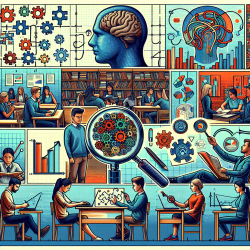Introduction
In the ever-evolving field of special education, practitioners are constantly seeking innovative methods to support students with developmental disorders. A recent research article, "Computational Modeling of Interventions for Developmental Disorders," offers groundbreaking insights into how computational models can enhance our understanding of interventions. This blog aims to inspire practitioners to improve their skills by implementing the outcomes of this research or by encouraging further exploration.
The Power of Computational Modeling
Computational modeling serves as a powerful tool in understanding the complex mechanisms underlying developmental disorders. By simulating various interventions, these models provide a unique perspective on how different strategies can impact learning outcomes. The research by Holyoak et al. (2019) evaluates connectionist models of developmental disorders, offering insights into the efficacy of interventions for reading, language, and other cognitive developmental disorders.
Key Findings and Implications
The research highlights several key findings that can guide practitioners in their intervention strategies:
- Long-term Outcomes: Computational models allow us to predict long-term outcomes of interventions, identifying potential compensatory outcomes and the resolution of early delays.
- Remediation Techniques: The study explores methods to remediate atypical development in a single network, emphasizing the importance of choosing better training items and altering computational properties.
- Compensation via Alternative Pathways: Encouraging compensation through alternative pathways is a key strategy, as it leverages the brain's plasticity to develop compensatory strengths.
- Individual Differences: Understanding individual differences in response to intervention is crucial. The study suggests that measures of processing should complement behavioral profiles to predict outcomes effectively.
Implementing Research Outcomes
Practitioners can implement these research outcomes by:
- Personalizing Interventions: Tailoring interventions to the unique needs of each student, considering their specific deficits and strengths.
- Utilizing Technology: Leveraging computational models to simulate potential interventions and predict their effectiveness.
- Collaborating with Experts: Engaging with researchers and experts in the field to stay informed about the latest advancements in computational modeling and interventions.
Encouraging Further Research
While the current research provides valuable insights, there is still much to explore. Practitioners are encouraged to engage in further research to expand our understanding of developmental disorders and interventions. Collaboration with academic institutions and participation in research studies can contribute to the advancement of the field.
Conclusion
The research on computational modeling of interventions for developmental disorders offers a promising avenue for enhancing intervention strategies. By embracing these findings and continuing to explore new possibilities, practitioners can unlock the potential of students with developmental disorders, helping them achieve their fullest potential.
To read the original research paper, please follow this link: Computational Modeling of Interventions for Developmental Disorders.










